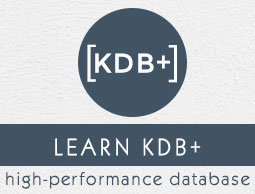Q 编程语言
Kdb+ 附带其内置编程语言q。它包含标准 SQL 的超集,该超集针对时间序列分析进行了扩展,并比标准版本提供了许多优势。任何熟悉 SQL 的人都可以在几天内学会q并能够快速编写自己的即席查询。
启动“q”环境
要开始使用 kdb+,您需要启动q会话。有三种方法可以启动q会话 -
只需在运行终端上输入“c:/q/w32/q.exe”即可。
启动 MS-DOS 命令终端并输入q。
将q.exe文件复制到“C:\Windows\System32”,然后在运行终端上键入“q”。
这里我们假设您正在 Windows 平台上工作。
数据类型
下表提供了支持的数据类型的列表 -
| 姓名 | 例子 | 查尔 | 类型 | 尺寸 |
|---|---|---|---|---|
| 布尔值 | 1b | 乙 | 1 | 1 |
| 字节 | 0xff | X | 4 | 1 |
| 短的 | 23小时 | H | 5 | 2 |
| 整数 | 23i | 我 | 6 | 4 |
| 长的 | 23j | j | 7 | 8 |
| 真实的 | 2.3e | e | 8 | 4 |
| 漂浮 | 2.3f | F | 9 | 8 |
| 字符 | “A” | C | 10 | 1 |
| varchar | `ab | s | 11 | * |
| 月 | 2003.03m | 米 | 13 | 4 |
| 日期 | 2015.03.17T18:01:40.134 | z | 15 | 8 |
| 分钟 | 08:31 | 你 | 17 号 | 4 |
| 第二 | 08:31:53 | v | 18 | 4 |
| 时间 | 18:03:18.521 | t | 19 | 4 |
| 枚举 | `u$`b,其中 u:`a`b | * | 20 | 4 |
Atomics和列表形成
Atomics是单个实体,例如单个数字、字符或符号。在上表(不同数据类型)中,所有支持的数据类型都是Atomics。列表是Atomics序列或包括列表的其他类型。
将任何类型的Atomics传递给单子(即单参数函数)类型函数将返回负值,即–n,而将这些Atomics的简单列表传递给类型函数将返回正值n。
示例 1 – Atomics和列表形成
/ Note that the comments begin with a slash “ / ” and cause the parser / to ignore everything up to the end of the line. x: `mohan / `mohan is a symbol, assigned to a variable x type x / let’s check the type of x -11h / -ve sign, because it’s single element. y: (`abc;`bca;`cab) / list of three symbols, y is the variable name. type y 11h / +ve sign, as it contain list of atoms (symbol). y1: (`abc`bca`cab) / another way of writing y, please note NO semicolon y2: (`$”symbols may have interior blanks”) / string to symbol conversion y[0] / return `abc y 0 / same as y[0], also returns `abc y 0 2 / returns `abc`cab, same as does y[0 2] z: (`abc; 10 20 30; (`a`b); 9.9 8.8 7.7) / List of different types, z 2 0 / returns (`a`b; `abc), z[2;0] / return `a. first element of z[2] x: “Hello World!” / list of character, a string x 4 0 / returns “oH” i.e. 4th and 0th(first) element
